A Devonian alga with peculiar features
(Part 4)

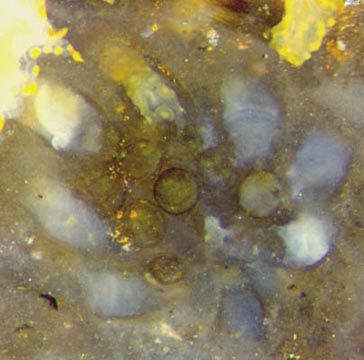
The hitherto overlooked Devonian alga,
first described under
this headline in Parts
1 to 3, offers more details worth reporting. The
whorl of 10 branches, cut near its base (Fig.1), would have been taken
for Palaeonitella
[1] if there were no
other whorls like baskets of branches with ellipsoidic capsules inside
(Fig.2).
Fig.1:
Charophyte alga whorl with 10 upward-bent branches (including a dark
one on the left). Slightly inclined cross-section, seen from above.
Fig.2: Charophyte alga
whorl with 10 upward-bent
branches forming a
basket, capsules inside. Inclined
cross-section, seen from below.
Size of all images 1mm2.
Two capsules in Fig.2, each with
a
dimly visible stalk, are
attached to a central columella, better seen in previously
shown pictures, here
concealed by a light-coloured spot. The branches are bent into the
picture plane, hence the cut basket is seen here from below. Apparently
the cut plane is sufficiently high above the branching point so that
several capsules have been cut.
The absence of capsules
in Fig.1
could
mean that either there were none or the cut plane was so close to the
branching site that none are seen on it.
In addition to the figures in Part 3, this Fig.2, too, can
possibly explain why the peculiar features of this alga have been
overlooked hitherto. Most often the capsules appear with low or
vanishing contrast, and with their width of usually 130Ám they are
easily mistaken for branch sections.
While
inspecting the samples with the "alga flowers", the attention was drawn
to another conspicuous structure, shown in the figures below.
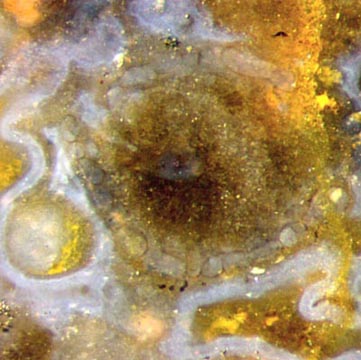
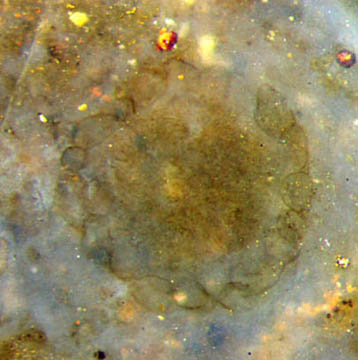
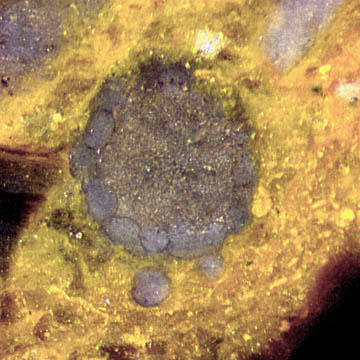
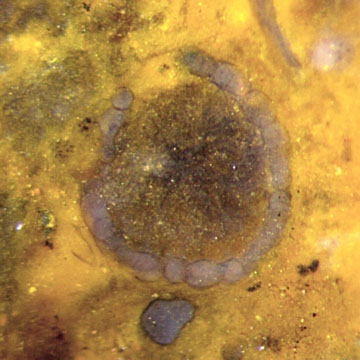
Figs.3-6:
Sections of globular organs thought to be antheridia of the Devonian
alga
distinguished by "alga flowers" described in previous
contributions.
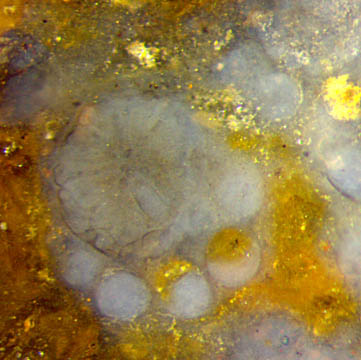
Fig.7: Antheridium with faint radial
streaks and a few alga branches close by.
The
wall of the organs in Figs.3-6 seems to be made of tightly fitting
cells which are much smaller than the cells forming the baskets with
the capsules. The fit implies that the cell cross-sections are
not circular like those of the branches. The fill of the globules
appears
granular in these images. The overall aspect suggests an interpretation
as early
antheridia. They seem to be evolutionary precursors of the charophyte
antheridia with more elaborate wall structure involving a smaller
number of well fitting cells.
The wall cells may have collapsed or decayed before silicification so
that a wall is not distinctly seen, as in Fig.7.
The faint radial streaks are compatible with the filamentous structure
of the charophyte antheridia.
The
recent observations reported here and in the preceding three parts pose
a veritable problem. With the globules of this "alga with
peculiar features" being quite similar to the antheridia
of the charophytes, and
the alga itself looking like a charophyte, and being found in the
Rhynie chert where also the charophyte
Palaeonitella
is found, it might
well be included into the charophytes. Now that the male organs are
known, most probably the "alga flowers" with their capsules are the
female organs, a conclusion which is incompatible with the charophytes
as we have known them, with the characteristic gyrogonites as the
female organs.
This
apparent incompatibility has to be overcome by suggesting an
evolutionary path from the "alga flower" to the gyrogonite. It
is
thinkable that a succession of evolutionary steps reduced the number of
capsules to one while the basket became narrower until the
branches wrapped around tightly and fused with the capsule into a
gyrogonite. This would have been a rather long path from the charophyte
shown here to the conventional ones with gyrogonites.
The
subject is complicated by the fact that there were already several
charophyte species with gyrogonites in the Lower Devonian [2]. Hence
the
evolutionary path to the gyrogonite must have been trodden a long
time before, which lets the alga with "flowers" appear as a relic from
those times
which has survived in the Rhynie habitat.
As
an intriguing fact, the ellipsoidal capsule wall appears so evenly
smooth
that one wonders where a sperm cell could enter. Did the alga shed the
capsules so that they germinated and formed archegonia ?
The
presently available fossil evidence on charophytes from the Rhynie
chert justifies another unconventional conclusion: Since gyrogonites
have never been seen attached to Palaeonitella
[1], some or most charophyte fossils
hitherto assigned to Palaeonitella
might really belong to this alga whose supposedly ancient features had
not been noticed in those finds.
Samples
found by: S.
Weiss in 2011 (Figs.1-4), 2013 (Figs.5,6), H.-J. W. in
2003 (Fig.7).
Fertile organs first seen in 2015 and 2016.
H.-J.
Weiss
2016
[1] R.
Kelman, M. Feist, N.H. Trewin, H. Hass :
Charophyte algae from the Rhynie chert,
Trans. Roy. Soc. Edinburgh,
Earth
Sciences 94(2004 for 2003), 445-455.
[2] T.N. Taylor,
E.L.Taylor, M. Krings: Paleobotany, Elsevier 2009.
 |
 |
93 |










